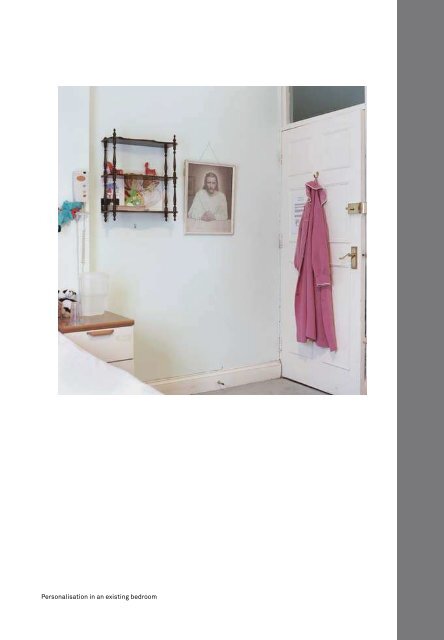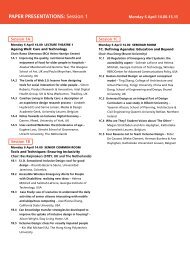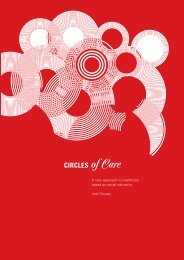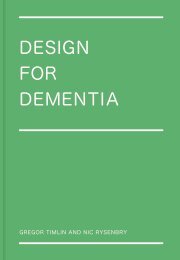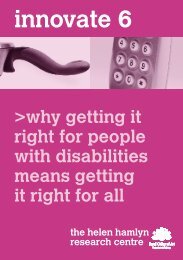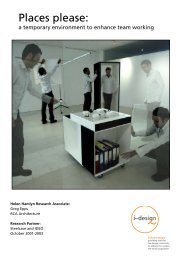Design for Dementia - Helen Hamlyn Centre - Royal College of Art
Design for Dementia - Helen Hamlyn Centre - Royal College of Art
Design for Dementia - Helen Hamlyn Centre - Royal College of Art
Create successful ePaper yourself
Turn your PDF publications into a flip-book with our unique Google optimized e-Paper software.
BEDROOM<br />
PERSONALISATION<br />
Personalisation is an expression <strong>of</strong> self.<br />
The ability to personalise one’s immediate<br />
environment can have invaluable impact<br />
on the life <strong>of</strong> a resident. It can help provide<br />
fundamental cues to their identity. Objects<br />
and images with personal meaning can<br />
provide valuable reminiscence tools <strong>for</strong><br />
staff, friends and family members to use to<br />
communicate with residents – and can also<br />
act to separate the resident’s personal space<br />
from the communal environment outside. An<br />
environment that is personalised with loved<br />
possessions and photographs – and thus<br />
unique to a person in care – can alleviate fears<br />
born out <strong>of</strong> confusion and help a resident feel<br />
safer and more at ease.<br />
Change and dementia do not mix well<br />
together. Major changes in a care resident’s<br />
life, routine and environment can cause a lot<br />
<strong>of</strong> stress and some new residents moving from<br />
their own home to care are known to exhibit<br />
an initial noticeable decline in abilities.<br />
A recent arrival into care was witnessed<br />
in a frightened state telling a carer, ‘I shouldn’t<br />
be here, I shouldn’t be here’. This person didn’t<br />
know where they were or why they were there.<br />
Simple interventions such as a few pictures<br />
on the wall <strong>of</strong> this individual and her family,<br />
a favourite lamp or a wardrobe full <strong>of</strong> familiar<br />
clothes could have provided cues to alleviate<br />
her fears.<br />
Personalisation <strong>of</strong> the environment can<br />
reduce anxiety <strong>for</strong> those moving into care,<br />
either autonomously or with the prompting <strong>of</strong><br />
carers, and demonstrate good care practice in<br />
really understanding the resident. Ownership<br />
<strong>of</strong> personal space can help achieve that all<br />
important and sometime elusive feeling<br />
<strong>of</strong> pride. A personalised room helps create<br />
communication tools <strong>for</strong> those residents<br />
who can no longer verbally communicate<br />
in the way they once did about their lives to<br />
friends, family, carers and other residents.<br />
It can also help provide a visual boundary<br />
between private and communal space, beyond<br />
the signifier <strong>of</strong> an internal door that is <strong>of</strong>ten<br />
left open.<br />
The contemporary personalisation <strong>of</strong><br />
private spaces within care varies a great deal.<br />
Most care providers are happy to let families<br />
redecorate a room to a resident’s personal<br />
tastes. However lack <strong>of</strong> money, time or local<br />
family means that this opportunity is rarely<br />
utilised; in most cases, only a few pictures,<br />
personal items or favourite pieces <strong>of</strong> furniture<br />
are brought in. When these personal items<br />
are removed from the context <strong>of</strong> a home and<br />
combined with standard care items such as<br />
well-used care beds and bedroom furniture,<br />
much <strong>of</strong> the personal value can be lost in<br />
the space.<br />
While there is much innovation in new<br />
architectural developments <strong>for</strong> people with<br />
dementia, most new care homes are retr<strong>of</strong>its.<br />
New facilities are being built in old hospitals<br />
or existing care homes, which have not been<br />
designed to cater <strong>for</strong> the needs <strong>of</strong> people<br />
with dementia. To be cost effective when retr<strong>of</strong>itting<br />
means using as much <strong>of</strong> what<br />
already exists as possible, and changing<br />
features and architecture can <strong>of</strong>ten be seen<br />
as an expensive exercise when the benefits<br />
are not truly understood.<br />
Personalisation in an existing bedroom<br />
73


